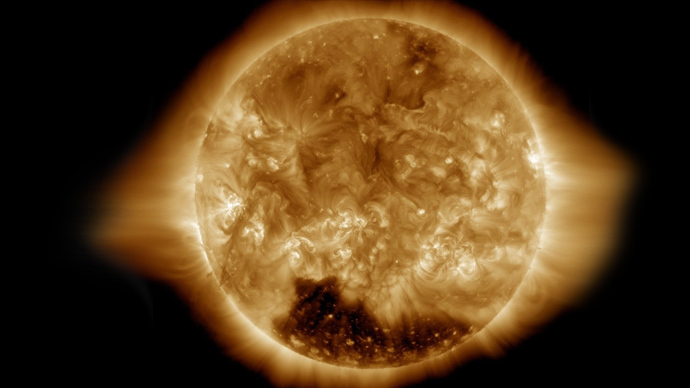NASA detects enormous 'coronal hole' on Sun’s South Pole (PHOTO)

A giant dark hole has appeared on the sun’s flaming surface, a recently-taken NASA picture has revealed. So far, scientists are stumped by why this spectacular phenomenon, known as a “coronal hole,” occurs.
“The Sun starts 2015 with an enormous coronal hole near the
South Pole,” scientists of NASA’s Solar Dynamics Observatory
wrote in their blog, having posted a picture of the flaming sun
with a gaping dark space in its lower part.
READ MORE: Spectacular space: The most stunning,
mind-boggling photos & videos of 2014!
What modern science knows is that “coronal holes” are
places where particles leave the sun’s surface at huge speeds -
of up to 500 miles per hour (800 kilometers per hour). What’s
still unclear is why this is happening.
The sun’s glowing comes from the “trapped” particles.
The coronal holes “contain little solar material, have lower
temperatures, and therefore, appear much darker.”
The first pictures of the phenomenon were taken by NASA
astronauts in the early 1970s.
With no fireworks on the sun, 2015 starts w/ a coronal hole near the south pole: http://t.co/ofIYN8QsVb@NASASunEarthpic.twitter.com/mjVhodlBlR
— NASA (@NASA) January 2, 2015
The coronal holes on the sun’s poles may be seen for five or more
years. Their shape can vary greatly, though.
It’s assumed that high-speed winds of solar particles coming out
of the sun’s dark holes can cause geomagnetic storms and auroras
on Earth.
NASA's Solar Dynamics Observatory (SDO), which detected the
latest coronal hole, participated late last year in the creation
of one of the most impressive images of the sun ever. SDO’s
picture was then combined with a photo of the sun’s X-ray
emissions taken by NASA’s Nuclear Spectroscopic Telescope Array.
READ MORE: Staring at the Sun: NASA takes
incredible solar portrait
In October 2014, just before Halloween, NASA took a photo of the
sun resembling a jack-o'-lantern.
The storms and flares on the surface of the sun actually gave a
carved pumpkin appearance to the sun, as seen from the Earth.
READ MORE: Space jack-o’-lantern! Amazing images of ‘The Pumpkin Sun’ revealed by NASA













